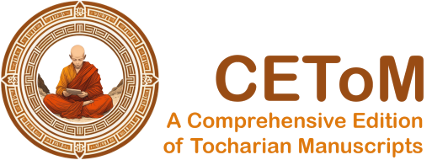Work in progress
PK LC 20
| Known as: | PK LC 20 |
|---|
| Cite this page as: | Adrian Musitz. "PK LC 20". In A Comprehensive Edition of Tocharian Manuscripts (CEToM). Created and maintained by Melanie Malzahn, Martin Braun, Hannes A. Fellner, and Bernhard Koller. https://cetom.univie.ac.at/?m-pklc20 (accessed 09 Jul. 2025). |
|---|
Edition |
| Editor: | Adrian Musitz |
|---|
Provenience |
| Collection: | Bibliothèque nationale de France, fonds Pelliot Koutchéen (Paris) |
|---|
Language and Script |
| Language: | TB |
|---|
Text contents |
| Text genre: | Non-literary |
|---|
| Text subgenre: | Letter |
|---|
| Verse/Prose: | prose |
|---|
Object |
| Material: |
on paper |
|---|
| Number of lines: | 5 |
|---|
Transliteration
| a1 | /// rsa pre ksau | ta tteṃ yṣū wa rka tā kaṃ ·e /// |
|---|
| a2 | /// [ś]ai pyā mtsa¯ ¯r | ceṃ ya kṣaṃ e te mā [ta] [k]· – [¯]tt sr[au] ka[ṃ] ma tsā ta¯ ¯r |
|---|
| a3 | /// seṃ e tā si mā ka rrā tta¯ ¯r we rwyi śke ne [o¯] ¯r a yā mä te |
|---|
| a4 | /// [ai] ś[ś]ai pyā [m]·¯ ¯r [n]· [st]·a si mā ta rka na¯ ¯t[t] ÷ |
|---|
| a5 | /// nai ma ñe pa leṃ tne 布 |
|---|
Transcription
Translation
| a1 | /// I ask with friendliness. | If he is friendly...n5 /// |
|---|
| a2 | /// Take care of...! | Don't let the yakṣas down belown6 . If they die, he will starve. |
|---|
| a3 | /// This etā-adjutantn7 scolds. Wood is not to be made (?) in the garden. |
|---|
| a4 | /// Take care of...! Don't let... /// |
|---|
| a5 | First month, on the day of the full moon. Bù. |
|---|
Commentary
Philological commentary
| * | There seems to be a phenomenon in the letters where the person addressed is simply written in the obliquus. In PK LC 27 a2, wiryaryaupte is written in the obliquus, followed by empty space, followed by a sentence in which Wiryaryaupte does not realy play a role. Cf. also the obscure document PK LC 24 sārwaṃnteṃ. This obliquus might be translated as 'concerning X', i.e. concerning Tatte, concerning Wiryaryaupte etc. |
|---|
| n1 | The 'pyā' looks a lot like 'ryā'. However, because of the direct parallel in a4, we should regard the top left of the akṣara as a very smushed together 'p'. |
|---|
| n2 | The 'rrā' has a horizontal line going through it like in 'kka'. |
|---|
| n3 | sic! This is a better reading than kärrāntär, since seṃ must be a nominative singular. This document in particular has a tendency to write double 'tt' where we would expect a single one (tärkanatt). Ching's translation of seṃ as the direct object is impossible. In addition, I segment etā simā, not etāsi mā. |
|---|
| n4 | Chinese signature bù 布 (literally “cloth”), compare PK LC 18. |
|---|
| n5 | This is a set phrase that occurs in the letters, cf. PK LC 16.1 kwri yes yṣuwar tākacer. |
|---|
| n6 | From the context, it would appear that yakṣa isn't the mythological creature known from Sanskrit, but rather an animal that was eaten. |
|---|
| n7 | If etā was the name of the adjutant, we would expect simā etā, cf. Ot 12 a11: simā kurriṅkāteṃtse |
|---|
References
Edition
Ching 2010: 148-149
Bibliography
Ching 2010
Ching, Chao-jung. 2010. “Secular documents in Tocharian: Buddhist economy and society in the Kucha region.” PhD, Paris: École Pratique des Hautes Études.


